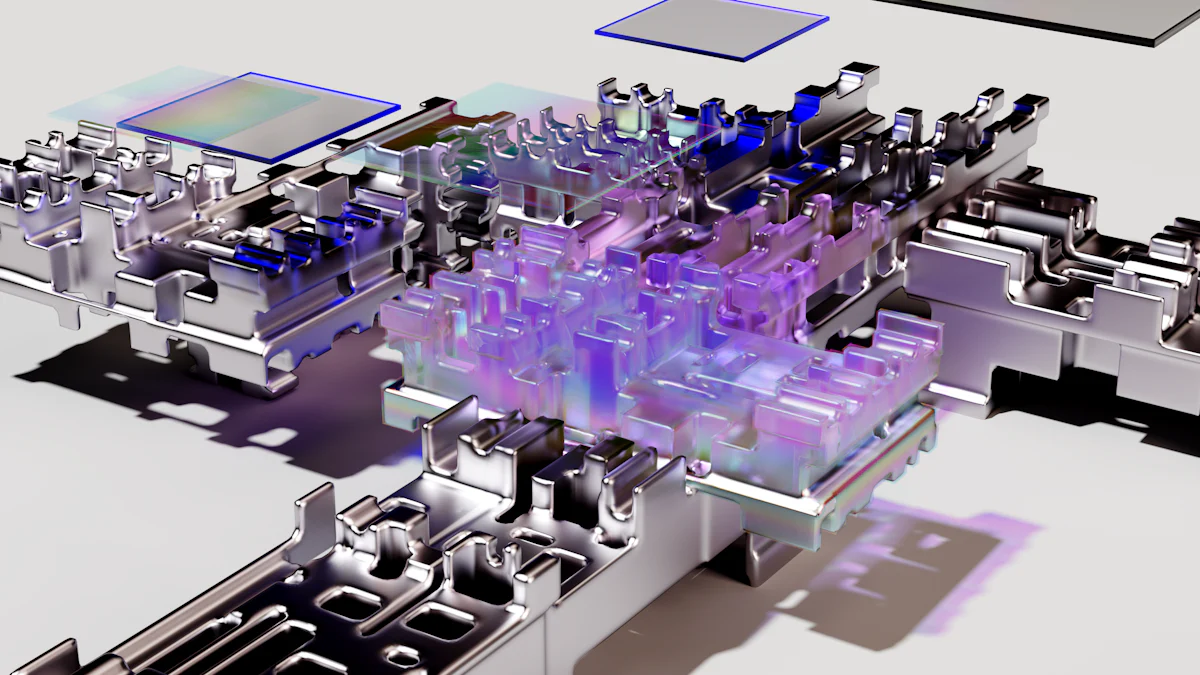Building AI Characters: A Step-by-Step Guide

AI characters have become essential in modern applications. Businesses increasingly integrate AI-driven interactions into their processes, with 44% already adopting some form of AI for content creation. The market for AI writing assistant software also shows a growth rate of 26.94%. Platforms like Character.AI leverage cutting-edge language models to create lifelike conversations. Myloves offers users the ability to create an AI lover, providing a personalized and immersive experience. This guide will explore the steps to build engaging AI characters using a character AI character definition template.
Understanding AI Characters
What are AI Characters?
Definition and key characteristics
AI characters represent digital entities powered by artificial intelligence. These characters simulate human-like interactions through advanced algorithms and machine learning models. Key characteristics include adaptability, contextual understanding, and the ability to learn from interactions. AI characters can process natural language, recognize patterns, and respond appropriately, creating a lifelike experience for users.
Examples of AI characters in use
AI characters have found applications across various platforms. For instance, virtual assistants like Siri and Alexa help users with daily tasks. In gaming, characters such as those in "The Elder Scrolls" series offer immersive experiences. Platforms like Myloves allow users to create personalized AI lovers, enhancing user engagement through customized interactions.
The Role of AI Characters in Various Industries
Entertainment and gaming
AI characters revolutionize the entertainment and gaming industries. Game developers use AI to create dynamic non-player characters (NPCs) that adapt to player actions. This enhances the gaming experience by providing unpredictable and engaging scenarios. Virtual influencers and AI-driven content creators also emerge, captivating audiences with unique and interactive content.
Customer service and support
Businesses leverage AI characters to improve customer service and support. AI-driven chatbots handle inquiries, resolve issues, and provide information efficiently. This reduces wait times and enhances customer satisfaction. Companies like Character.AI utilize large language models to generate realistic responses, ensuring seamless interactions.
Education and training
AI characters play a significant role in education and training. Educational platforms use AI tutors to provide personalized learning experiences. These characters adapt to individual learning styles and pace, improving knowledge retention. In corporate training, AI characters simulate real-world scenarios, helping employees develop skills and retain information effectively. For example, the case study of "Creating Nouna" demonstrates the effectiveness of AI characters in corporate training, leading to better retention of information and increased customer loyalty.
Planning Your AI Character
Defining the Purpose and Scope
Identifying the Target Audience
AI character development begins with identifying the target audience. Understanding the demographics, preferences, and needs of potential users ensures that the character resonates well. For instance, a virtual friend for teenagers may differ significantly from an AI presenter for a professional audience. The target audience influences the design, functionality, and interaction style of the AI character.
Determining the Character's Role and Functionality
Defining the role and functionality of the AI character is crucial. The character's purpose dictates the features and capabilities required. For example, an AI tutor in an educational platform needs to provide personalized learning experiences. Conversely, an AI customer service agent must handle inquiries and resolve issues efficiently. Clear objectives guide the development process, ensuring the character meets user expectations.
Designing the Character's Personality
Traits and Behaviors
Character traits and behaviors form the foundation of an engaging AI character. Developers must decide on attributes such as friendliness, professionalism, or humor. These traits influence how the character interacts with users. For example, a charming AI lover on Myloves requires a warm and affectionate demeanor. In contrast, an AI business consultant should exhibit professionalism and expertise. Consistent traits and behaviors create a cohesive and believable character.
Voice and Tone
The voice and tone of an AI character significantly impact user experience. The character's voice should align with its personality and role. For instance, a soothing and calm voice suits an AI therapist, while an energetic and enthusiastic tone fits a fitness coach. Developers can use advanced technologies like text-to-speech to customize the character's voice. The tone of communication should also match the context, ensuring appropriate and effective interactions.
"AI tools allow us to create something incredibly personal and unique: your very own AI-generated character," said AI developers.
Technical Foundations
Choosing the Right AI Framework
Overview of Popular AI Frameworks
Selecting an appropriate AI framework is crucial for developing robust AI characters. Several frameworks stand out due to their unique features and capabilities:
- Hugging Face Transformers: Ideal for language tasks, these models expedite AI development by providing pre-trained models. Compatibility with TensorFlow and PyTorch enhances their utility.
- TensorFlow: Known for its scalability and extensive community support, TensorFlow suits large-scale projects and mobile applications. Distributed training capabilities make it a versatile choice.
- PyTorch: Favored by researchers and academics, PyTorch offers a dynamic computation graph and an intuitive Python interface. Its flexibility makes it suitable for experimental and academic projects.
- Keras: With a user-friendly interface, Keras excels in deep learning and neural network prototyping. Running on TensorFlow, it simplifies model development.
- AWS SageMaker: This platform excels in deploying machine learning models efficiently. Features like Training Jobs and hyperparameter tuning with Bayesian Optimization streamline the development process.
Criteria for Selection
Choosing the right framework depends on several factors:
- Project Requirements: Identify the specific needs of the project. For instance, language tasks may benefit from Hugging Face Transformers, while large-scale projects might require TensorFlow's scalability.
- Ease of Use: Consider the learning curve associated with each framework. PyTorch offers an easy-to-understand interface, making it ideal for beginners.
- Community Support: A robust community can provide valuable resources and support. TensorFlow's large community is beneficial for complex projects.
- Compatibility: Ensure the framework integrates well with existing tools and platforms. Keras, running on TensorFlow, offers seamless integration.
- Performance: Evaluate the performance metrics of each framework. AWS SageMaker's efficient deployment capabilities can enhance overall performance.
Data Collection and Preparation
Types of Data Needed
Data forms the backbone of AI character development. Different types of data are essential for training and refining AI models:
- Text Data: Includes dialogues, scripts, and written content. Text data helps in training natural language processing (NLP) models.
- Audio Data: Comprises voice recordings and sound clips. Audio data is crucial for developing text-to-speech and speech recognition capabilities.
- Image Data: Encompasses photographs, drawings, and visual content. Image data aids in creating realistic visual representations of AI characters.
- Behavioral Data: Involves user interaction logs and behavioral patterns. Behavioral data helps in personalizing AI character responses.
Methods for Data Collection
Effective data collection methods ensure the quality and relevance of the data:
- Surveys and Questionnaires: Collect user preferences and feedback through structured surveys. This method provides valuable insights into user expectations.
- Web Scraping: Extract data from websites and online platforms. Web scraping gathers large volumes of text, audio, and image data.
- Public Datasets: Utilize publicly available datasets for training. Public datasets offer a diverse range of data types and sources.
- User Interactions: Record interactions between users and existing AI systems. User interaction logs provide real-world data for refining AI models.
Data Preprocessing Techniques
Preprocessing ensures the data is clean and ready for training:
- Data Cleaning: Remove noise and irrelevant information from the dataset. Data cleaning improves the accuracy of the AI model.
- Normalization: Standardize data formats and scales. Normalization ensures consistency across the dataset.
- Tokenization: Break down text data into smaller units like words or phrases. Tokenization facilitates efficient processing by NLP models.
- Augmentation: Enhance the dataset by adding variations. Augmentation increases the diversity and robustness of the training data.
By following these technical foundations, developers can build efficient and effective AI characters. Proper framework selection, data collection, and preprocessing lay the groundwork for successful AI character development.
Building the AI Character

Developing the Character's Core Logic
Algorithms and Models
Developing the core logic of an AI character requires selecting appropriate algorithms and models. Large Language Models (LLMs) like GPT-3 and BERT serve as the foundation for many AI characters. These models process vast amounts of text data to generate human-like responses. Emotional intelligence algorithms enhance interactions by interpreting and responding to user emotions. Machine learning techniques analyze patterns in existing characters and story arcs to create unique personas. This combination of technologies ensures that AI characters deliver engaging and lifelike conversations.
Training the AI
Training the AI involves feeding the model with relevant data and refining its responses. Text data, including dialogues and scripts, form the basis of training. Developers use supervised learning techniques to guide the AI in generating appropriate responses. Reinforcement learning further improves the model by rewarding desirable behaviors and penalizing undesirable ones. Continuous training and fine-tuning ensure that the AI character adapts to new information and user interactions, providing a tailored experience.
Integrating Natural Language Processing (NLP)
Understanding NLP Basics
Natural Language Processing (NLP) enables AI characters to understand and generate human language. NLP involves several key components:
- Tokenization: Breaking down text into smaller units like words or phrases.
- Part-of-Speech Tagging: Identifying the grammatical roles of words.
- Named Entity Recognition: Detecting and classifying entities like names and dates.
- Sentiment Analysis: Assessing the emotional tone of text.
These components work together to enable AI characters to process and respond to user input effectively.
Implementing NLP in Your Character
Implementing NLP in AI characters involves integrating these components into the character's core logic. Developers use pre-trained NLP models like those from Hugging Face Transformers to expedite this process. Fine-tuning these models with domain-specific data enhances their performance. For instance, an AI lover on Myloves would require training on romantic dialogues and affectionate language. This customization ensures that the AI character communicates in a manner consistent with its intended role and personality.
Introducing "Myloves"
Overview of "Myloves" and Its Capabilities
Myloves offers users the ability to create personalized AI lovers. The platform provides tools to customize every detail of the virtual companion, including appearance, personality traits, and voice. Advanced technologies like text-to-image generation and text-to-video integration bring these characters to life. Users can interact with their AI lover through various forms, such as chatting and voice communication. Myloves prioritizes privacy and data security, ensuring that all interactions remain confidential.
How "Myloves" Can Enhance Your AI Character
Myloves enhances AI characters by offering a highly customizable and immersive experience. Users can define specific personality traits and behaviors, creating a unique virtual companion. The platform's advanced NLP capabilities ensure that the AI lover responds appropriately to user input. This level of personalization increases user engagement and satisfaction. By leveraging Myloves, developers can create AI characters that resonate deeply with users, providing meaningful and memorable interactions.
Testing and Refining

Conducting Initial Tests
Setting up test scenarios
Developers must create diverse test scenarios to evaluate AI characters effectively. These scenarios should cover various interaction types and user inputs. For instance, testing an AI customer service agent involves simulating common customer inquiries and complaints. Developers should also consider edge cases where users might provide unexpected or ambiguous inputs. Comprehensive test scenarios ensure that AI characters handle a wide range of interactions smoothly.
Gathering feedback
User feedback plays a crucial role in refining AI characters. Developers should implement mechanisms for collecting feedback from real users. Surveys and questionnaires can gather insights into user satisfaction and areas needing improvement. Monitoring user interactions provides valuable data on how AI characters perform in real-world situations. Feedback helps identify issues that may not surface during initial testing, ensuring continuous improvement.
Iterative Improvement
Analyzing test results
Analyzing test results involves examining the performance of AI characters across different scenarios. Developers should look for patterns in user interactions and feedback. Metrics such as response accuracy, user satisfaction, and interaction completion rates provide quantitative data. Qualitative feedback from users offers insights into the character's personality and behavior. A thorough analysis helps pinpoint strengths and weaknesses in the AI character's design.
Making necessary adjustments
Based on the analysis, developers should make necessary adjustments to improve the AI character. This may involve fine-tuning algorithms, updating training data, or modifying personality traits. Continuous iteration ensures that the AI character evolves to meet user expectations. Regular updates and refinements keep the character relevant and engaging. By prioritizing user feedback and iterative improvement, developers can create AI characters that deliver exceptional user experiences.
Deployment and Maintenance
Deploying Your AI Character
Choosing the right platform
Selecting the appropriate platform for deploying an AI character is crucial. AWS SageMaker and Azure ML stand out as top choices. AWS SageMaker offers a pay-as-you-go system, providing flexibility in managing expenses. This platform integrates seamlessly with other AWS services, ensuring fast deployment. Azure ML, on the other hand, excels in cost-saving features like Spot Instances for long-running jobs. This platform fits well within Microsoft setups, making it ideal for those already using Azure services.
When choosing a platform, consider the existing infrastructure and specific needs of the project. AWS SageMaker's extensive network of resources supports large-scale deployments efficiently. Azure ML focuses on features like MLOps, enhancing the overall machine learning lifecycle. Both platforms offer robust solutions, but the choice depends on the project's unique requirements and existing technological ecosystem.
Ensuring scalability and performance
Ensuring scalability and performance is essential for the success of an AI character. Scalability allows the system to handle increasing loads without compromising performance. AWS SageMaker and Azure ML both provide tools to achieve this. AWS SageMaker's integration with other AWS services facilitates rapid scaling. Azure ML's compatibility with Microsoft's offerings ensures smooth scalability within Azure environments.
Performance optimization involves monitoring and adjusting various parameters. Load testing helps identify bottlenecks and areas for improvement. Implementing caching mechanisms can reduce response times. Regularly updating the underlying models ensures that the AI character remains efficient and effective. By focusing on scalability and performance, developers can create a robust and responsive AI character.
Ongoing Maintenance and Updates
Monitoring performance
Continuous monitoring of an AI character's performance is vital. Performance metrics such as response time, accuracy, and user satisfaction provide insights into the system's effectiveness. Tools like AWS CloudWatch and Azure Monitor offer comprehensive monitoring solutions. These tools track various performance indicators and generate alerts for potential issues.
Regular performance reviews help identify trends and areas needing attention. Analyzing user interactions provides valuable data for refining the AI character. Monitoring ensures that the system operates smoothly and meets user expectations. By keeping a close eye on performance, developers can maintain a high-quality user experience.
Regular updates and improvements
Regular updates and improvements keep an AI character relevant and engaging. Updating the underlying models with new data enhances the character's capabilities. Fine-tuning algorithms based on user feedback ensures that the AI character adapts to changing needs. Implementing new features and functionalities keeps the system fresh and exciting for users.
Developers should schedule periodic reviews to assess the AI character's performance and make necessary adjustments. Incorporating user feedback into the development process leads to continuous improvement. Regular updates ensure that the AI character remains at the forefront of technological advancements. By prioritizing maintenance and updates, developers can deliver a consistently high-quality experience.
Building AI characters involves several key steps. Developers must understand the foundational concepts, plan the character's purpose and personality, establish technical foundations, build the core logic, integrate NLP, and conduct thorough testing. Well-designed AI characters can significantly impact various industries, from entertainment to customer service. The potential for creating engaging and lifelike interactions is immense.
Developers should start building and experimenting with AI characters. The future of AI characters holds exciting possibilities. Continuous advancements in technology will further enhance the realism and functionality of AI characters.
See Also
Customizing Your AI Companion: A Detailed How-To Guide
Best Resources for Crafting Lifelike AI Characters in 2024
Understanding AI Character Profiles: Essential Information
Crafting Original DnD Characters Using AI Technology
Insight into VisualCharacter AI: Key Information to Understand